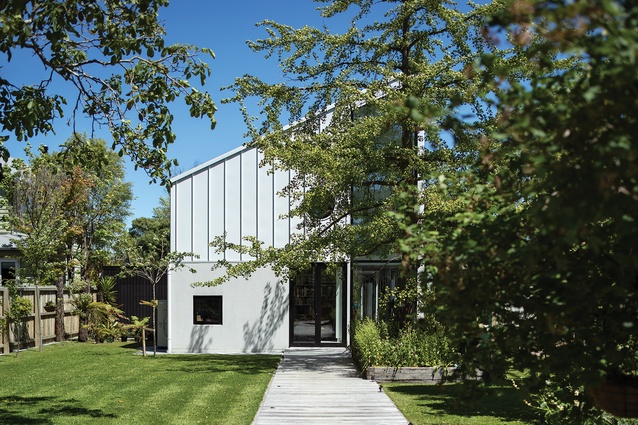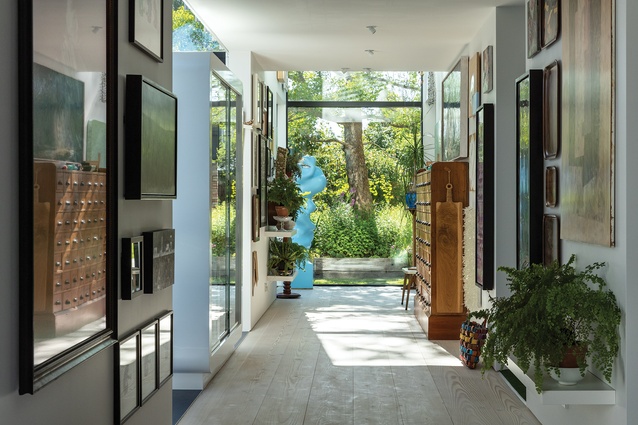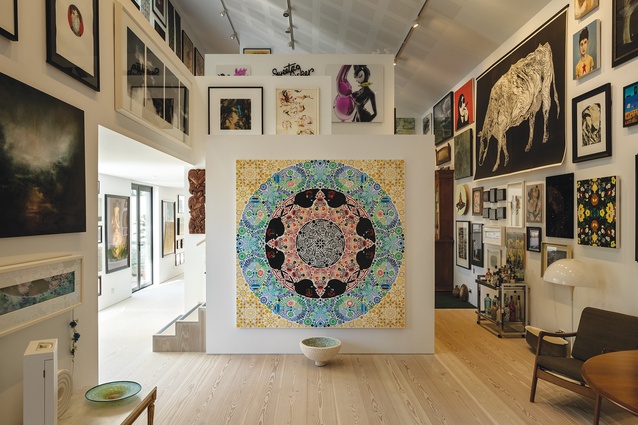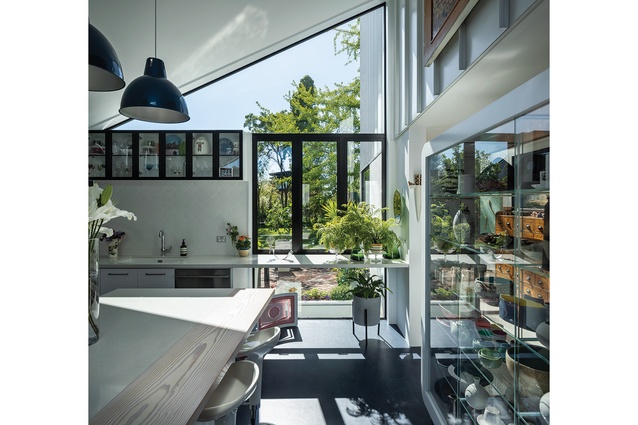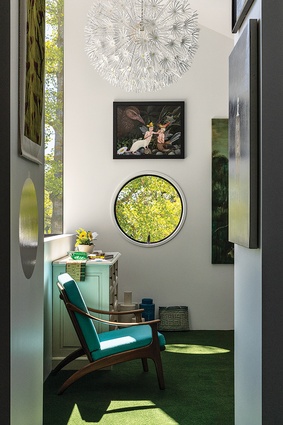Gallery house
Jeremy Smith discovers the Wrightmann House in Christchurch, where considered architectural curatorship by Athfield Architects has given every wall a voice.
There is nothing like a good art gallery: just so much to see, learn and take home. Somehow, you never see everything, which then keeps you heading back for more. So, why not remove the circling and figuratively become lost in your own gallery? Why not wander around being inspired under starlight or with your morning cornflakes? Why not make house by making gallery?
Athfield Architects has done just this in suburban Christchurch for two avid collectors and curators: Anthony Wright and Selene Manning. Amongst other things, they direct the Canterbury Museum and run a classic car restoration company, respectively. Athfields calls the building the Wrightmann House but it deserves having a ‘gallery’ prefix added. For, while the neighbours tackle their long narrow sites with house walls, or townhouse walls as seems increasingly the norm down here, architect Trevor Watt and team conceive proper gallery walls. The two aren’t the same. Next door, I envisage the walls work to enclose and separate space. They may even have a long hall and colloquially call it a gallery but there is so much more to facilitating the curatorship of art.
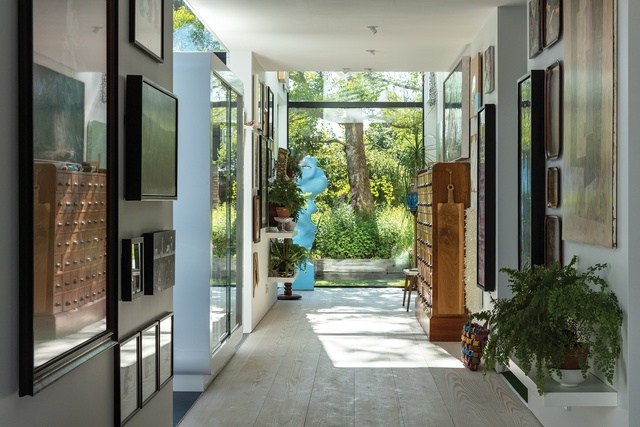
Art doesn’t have to be in a gallery, of course, but a gallery is there as a place to house and view art, and to incite debate. Art works at different scales: up close, from a distance, and at angles and moments to affect us all differently. So, in addition to walls and the physical surfaces for placing art, galleries require the corners, pausing and reflection spaces that let us rest on things for a while. And, to help us take in all this visual stimulus, a continuity to planning helps to keep discussions open.
As Héctor Zamora prompts in placing his current Lattice Detour wall installation within or, more accurately, on The Met’s New York roof,1 gallery walls have value in their own right. They “question our understanding of the space, of interaction, of humanity”2 and, as he suggests on the Met’s Instagram feed, walls start conversations. Curators then allow the voices to be heard and the placement of not just the work but dialogue. I spot Jacinda up there on the wall, her portrait chaining between Jesus on one side and Mary the other. It’s all up for discussion: religion, politics, humour, even late-eighties’ goth pop.
So you need a curator’s eye, collection and keenness to take this on and, of course, lots of picture hooks. We all ruin our freshly painted walls enthusiastically hanging art. Placing all this took a year, so picture the putting up and taking down, the discussions, the pleasure in having gallery double-lined walls, which allow nailing anywhere. Still, I imagine there’s a few “a bit higher and to the left please” moments behind it all and, no doubt, some more to come. The art in this gallery-house won’t stay idly fixed for long; there are discussions to be had.
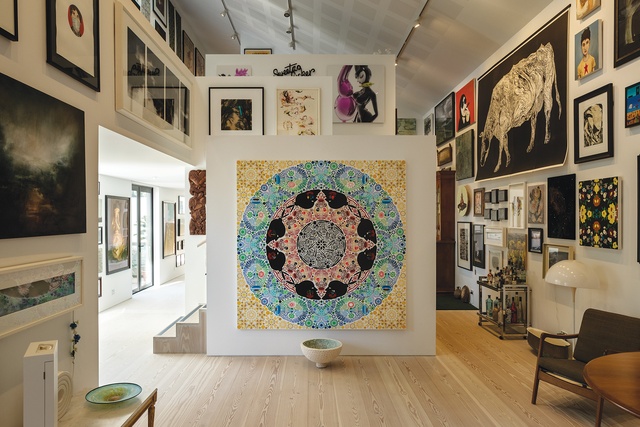
To achieve all this, Athfield Architects sit the building tight to the south boundary. Kitchen and living areas then step north from the main double-height space and out into the garden to make those quieter contemplation spaces, which, remarkably, still come with a seat, cake and coffee. Here, the house grabs and softly distributes light and frames the world outside. The scale feels right: not a house-sized Tate Modern but certainly something larger than expected. Circulation loops around internal storage and up a stairway with less wind than the Guggenheim, but where doors are equally hard to find and separate off only the guest, garage and utility lodgings.
And the colour: from up on the mezzanine, suburbia outside appears through the narrow vertical windows as some kind of banal beige portrait. Utopia is clearly in here with the reds, the blues, the yellows and the colours between. Only the ceiling remains uncovered but it can’t be long before all those acoustic perforations germinate some kind of Yayoi Kusama dot reaction. With all this life inside, even the garden space out the back takes on a suburban oasis-like respite.
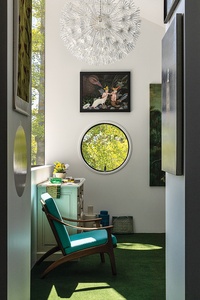
Yet suburbia doesn’t need to be a dirty word for, as Richard Sennett explains, “the built environment is one thing, how people dwell in it another”.3 The architects provide wall space here, too. Galleries give, and this one is set back behind a raised planter housing a flower bed and a copper beech tree that is silhouetted against the white metal cladding; canvas number one is for the street. The elevation is then replayed at the other end to capture shadow from a ginkgo tree. Throw in a round window and it’s playtime in the continuum between and wonderfully happy.
This is an important time for Christchurch, having lost so much continuity in the quakes. It’s hard not to draw the steeply pitched, extruded roof form back regionally to Miles Warren’s Cambridge Terrace House and Offices, which are now almost sacred in their housing of practice, professional body and design life in Christchurch. So much wonderful work emerges from the various practices warrened in here. It is no ordinary place and the building and the lodgings above Miles’ gallery here were important to Ian Athfield’s work and leadership in the imagining of post-quake Christchurch.4
As Athfield Architects heads into the future, the flat where Ath worked and stayed is still in use, compassionately housing and educating stranded architects like me, complete with drawing board. It all points to Watt and team understanding and forwarding the lineage. The paintbox looks well stocked.
I doubt streaming services would favour us all having gallery-houses; there would be too much competition to their download quotas. Yet, somehow, art doesn’t compete. It can be curated to talk or even debate but it’s hardly a ratings game – not on these Wrightmann picture hooks anyway. This house lets you go where your eye takes you and then packages the art into thoughts to take home.
It makes me think about all the veils, pattern-making, screens and gymnastics going on in Christchurch’s inner city rebuild. Galleries are able to make new holes in walls and rehang their stories, while buildings seem conditioned to play a far longer game in structuring their picture hooks. What’s arriving downtown is thankfully far from a monotonous suburban beige but I hope it doesn’t all feel too competitive between neighbouring buildings and warrant some shuffling. Moving “a little to the left please” won’t be easy and I wonder where architectural curatorship fits at a larger scale? A good gallery does that.

